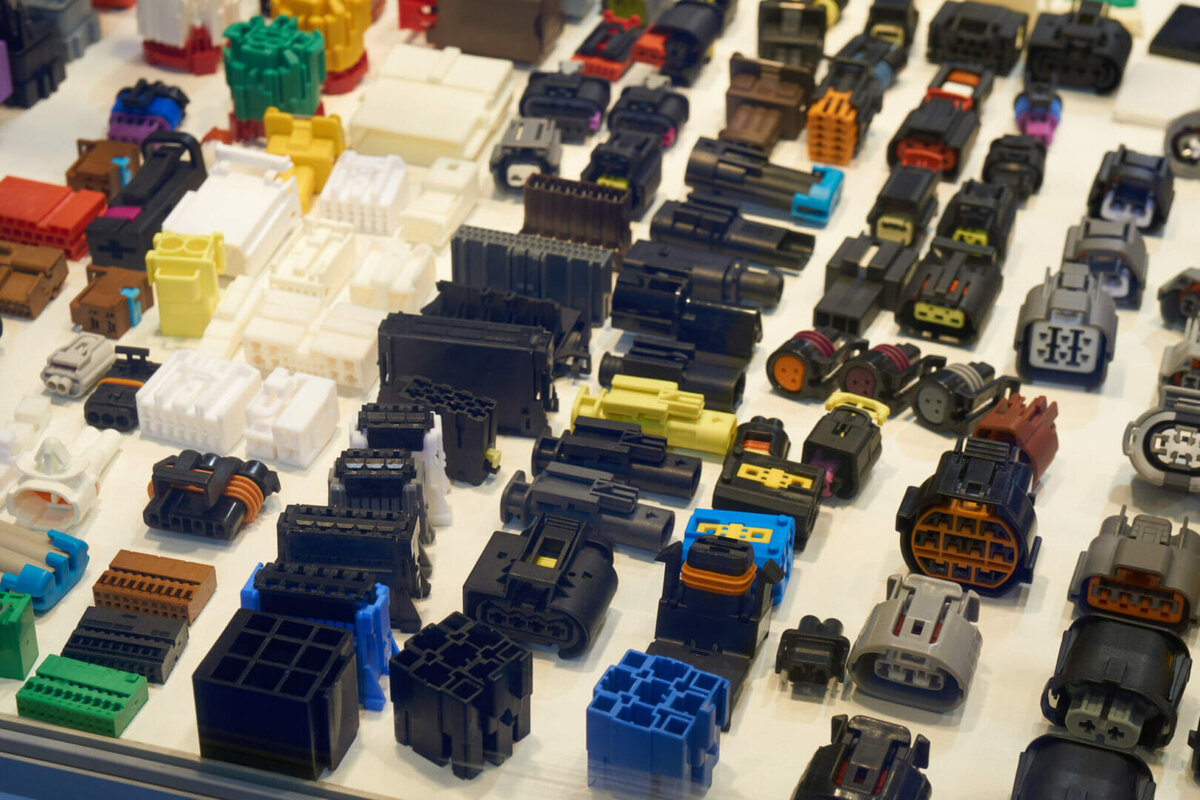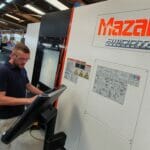Multi-component manufacturing to the injection moulding world is what flares are to the fashion world. Both have been around for a long time and their popularity ebbs and flows. And just as wide legged trousers made a comeback on the catwalks in 2019, so multi-component moulding is currently undergoing a surge in popularity, as it evolves in new directions.
According to the latest report issued by Transparency Market Research, the global market for multi-component moulding is anticipated to reach US$ 11.58 billion by 2024[i].
Automotive industry in the driving seat
The automotive industry commands the lion’s share of the market, accounting for approximately 30% of European demand for multi-component parts. This sector looks set to remain strong, driven by advancements in touchscreen electronics and the advent of sophisticated multi-face tooling that allows for in-mould finishing and assembly.
The trend here is towards producing a single component that would have historically required several separately moulded parts and off-mould processes. For example, by combining multi-component moulding with touchscreen technology, a car dashboard can be moulded as a single element with the HMI functionalities sandwiched between the plastic. As well as looking smart, this reduces the cost of production by eliminating the need for laser cutting, etching etc.
Another example of a growing automotive application is the production of the bezels that surround satellite navigation systems. The electronic touchpad for the ‘sat nav’ is laid inside the mould, then trimmed and tested ready to go straight into the vehicle.
But although automotive parts account for the majority of applications, other industries – medical devices, consumer goods, packaging and electronics – are predicted to experience the biggest growth in multi-component moulding over the next five years.
Aesthetic appeal and functionality
In FMCG manufacturing, multi-component moulding appeals to brand leaders seeking innovative and creative ways to integrate multiple colours, resins and sensory features into products, in order to provide differentiation. Combinations of materials, such as silicones and thermoplastics, PP and opaque thermoplastics like ABS, or hard plastics with a soft-touch material, are especially popular in the personal care market. Some of the most common examples include disposable razors, toothbrushes and bottle caps.
However, as sustainability has climbed the corporate agenda, interest has shifted away from multi-material moulding and towards multi-colour moulding, as this enables the production of fully recyclable mono-material components. Some brands in the premium spirits space have adopted this approach.
In the medical device segment, the driver behind multi-component moulding is creating precision moulded products with specific physical properties and functionalities. Adding a sealing solution, for example diaphragms, O-rings, gaskets and lip seals, to a medical component is critical to ensure resistance to potentially harmful and toxic chemicals and prevent cross contamination risks.
Filling a gap
Sandwiching applications that go beyond burying low cost scrap material within a part are another major growth area. From a circular economy standpoint, sandwich moulding offers options to integrate recycled materials for the inner part of the component. Examples include the trays used for protecting kitchen appliances during transit or for transporting automotive parts around a factory, with a filling from lower value recycled material.
As rising demand for recycled materials closes the price differential with virgin materials, moulders are looking to other ways of filling the cavity. The use of gas injection to hollow out the centre of the product, for example, makes it easier to recycle, plus there is the cost benefit that comes from a reduction in weight, material usage and cycle time.
Pros and cons
Injection moulders are realising how much they can save by producing a finished part in the mould without the use of downstream equipment that takes up floor space and is expensive to buy, operate and maintain. In its most basic form, multi-component moulding removes the ‘assembly’ stage, whether clipping or gluing, reducing assembly costs by up to 20%. The fact moulding takes place within one cycle also means it is more productive than conventional moulding – total manufacturing cycle time may be trimmed by up to 20% due to less handling of the part.
However, there are downsides to multi-component manufacturing. Capital investment is higher than with a standard press. This is partly because many multi-component or co-injection presses are customised, making them more expensive, but also because tooling costs are higher due to the complexity; it is more difficult to repurpose the mould for different products than it is with a standard injection moulding process. In addition, the product design process and operation of the machine are far more complicated for multi-component products.
Many of the disadvantages of multi-component manufacturing stem from the fact it has historically been performed on hydraulic machines. These are difficult to configure for different materials – the pump system may have to be changed, for example. They are also heavy on energy consumption as the hydraulic motor is connected to an electric power unit that works at maximum power in every phase of the moulding process.

When working with two materials, perfecting the injection process control is even more critical on electronic safety applications like connectors
All-electric has the answers
All-electric multi-component systems are starting to emerge as a viable alternative, offering speed, precision and energy efficiency advantages over their hydraulic counterparts.
When working with two materials, perfecting the injection process control is even more critical given that a second material is being injected on top of the first shot. All-electric machines use servo drives, enabling moulders to achieve greater precision and repeatability. For example, servo technology is critical for the smooth and fast rotation of the mould between the injection of the first and second material in order to ensure components are perfectly positioned to receive the second shot. Ultimately, this more precise operation translates to shorter cycle times compared to hydraulic concepts.
Electric machines also consume less energy because they have several servomotors, one for each machine function, only working when required. With hydraulic machines, the pump is always on and working, even when the machine is idle.
So although the initial capital outlay is higher, an electric machine will yield a viable ROI (return on investment) through lower energy consumption, reduced maintenance and faster cycle times.
Next generation multi-shot machine
September 2019 saw the launch of the IntElect2 Multi, Sumitomo (SHI) Demag’s most advanced multi-component electric machine yet. This new machine addresses the global movement towards more complex parts that feature two different materials.
With its dynamic motor design, the IntElect2 Multi promises an increase in production output of up to 20%, a reduction in energy consumption of up to 60% and faster ROI – typically around 18 months – compared to its predecessor.
The machine fills a gap in the market for a more compact, energy efficient, multi-component injection moulding system. Historically, multi-component machines have been designed on a large footprint to accommodate the tool and turntable. This is because, when co-injecting multiple materials, the number of cavities usually doubles, plus, rotating the mould 180° by turntable requires more mould space. By increasing the mould space on the IntElect2 Multi, Sumitomo’s engineers have succeeded in developing a multi-component machine that is in fact more compact.
Given the complexity and value of multi-component tools, the IntElect2 Multi includes an advanced mould safety system as standard. Featuring high resolution sensors built into the toggle system itself, the machine can detect even the slightest change in force patterns and respond accordingly. Additionally, the machine assists moulders in monitoring ejector force, enabling the detection of parts and mould elements that have jammed, issues that arise with wear in the ejector system and broken ejector rods.
The versatile machine is equally suited to sustainability-led sandwich moulding. This allows for the production of soft-touch lids for shampoo bottles or toothbrushes that are overmoulded with different colours in soft TPV, for example. Additionally, moulders can use an inner foam material wrapped in a rigid plastic, resulting in a lighter weight component and savings on materials, or combine hard and soft materials to improve the aesthetics and comfort of parts. Another option, covering an inner glass fibre material with an unfilled material, delivers increased stiffness and creates a brilliant surface.
Making more of the ‘multi’ trends
With the market set to expand by a steady CAGR of 6.5% in the next four years, the resurgence of multi-component is clearly here to stay. Nigel Flowers concludes: “As well as opening up new windows of opportunity for creating more sustainable components, the process helps to strip costs out of production and assembly and also helps to enhance consumer brands from an aesthetic point of view. As all-electric multi-shot injection moulding technology comes of age, the barriers to entry – mainly around complexity and cost – are being eroded, making multi-component manufacturing commercially viable and lucrative in new applications.”
[i] https://www.transparencymarketresearch.com/pressrelease/2-shot-injection-molding-market.htm








